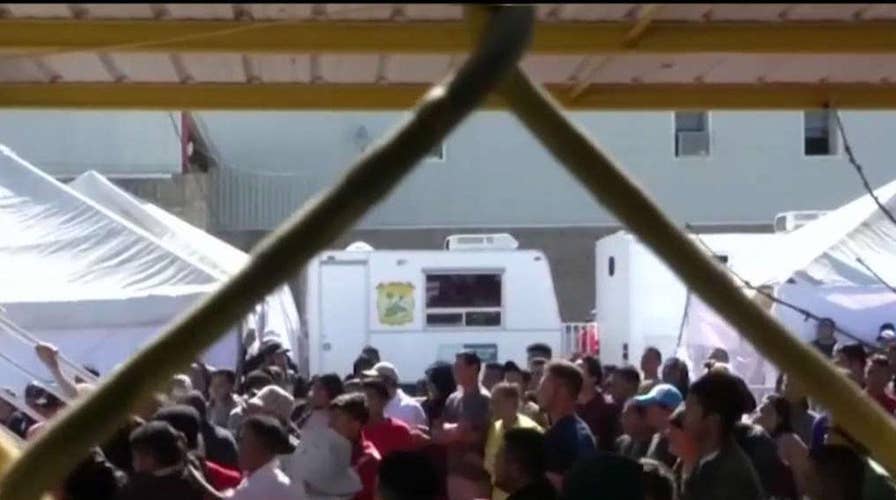Tensions mount at Eagle Pass port of entry as Border Patrol processes asylum-seekers
U.S. Customs and Border Protection officials face the arduous task of processing each caravan migrant; Casey Stegall reports.
Because of multiple lawsuits challenging his declaration of a national emergency, we don’t know if President Trump will be able to carry out his plans to use $8 billion in federal funds to build a barrier along parts of the U.S.-Mexico border to reduce illegal immigration.
But even if the courts side with the president – and even if he then uses billions of dollars more to build additional sections of a border barrier – no wall or fence alone will stop immigrants from crossing our southern border in large numbers.
That’s because in recent years illegal immigrants have learned to exploit loopholes in our asylum laws. Many voluntarily turn themselves in to Border Patrol agents as soon as they cross into the U.S. and fraudulently claim asylum.
Illegal immigrants have been told back in their home countries that requesting asylum unlocks the door to America. Simply making a request will prevent the U.S. government from immediately deporting the person seeking asylum.
SUPREME COURT REJECTS TRUMP BID TO ENFORCE ASYLUM CRACKDOWN
Instead, each asylum claim is referred to federal immigration court, where it takes an average of 578 days for a decision to be reached on a request.
Because of this huge court backlog, more than 809,000 immigrants are waiting for their asylum claims to be heard in immigration court. That’s enough people to create the 18th largest city in the U.S.
A wall wouldn't keep out these asylum seekers, who could simply turn themselves in at legal points of entry. To reduce this flow of illegal immigrants, the White House and Congress must close asylum loopholes.
While waiting for a decision on their asylum claims, illegal immigrants get to stay in the U.S. Many don’t show up when their immigration court hearings are finally scheduled and simply continue staying in America illegally. Approximately 600,000 people disappeared before their asylum hearings between 2003 and 2015.
A wall wouldn't keep out these asylum seekers, who could simply turn themselves in at legal points of entry. To reduce this flow of illegal immigrants, the White House and Congress must close asylum loopholes.
Our asylum system wasn't always so prone to abuse. Before 2009, courts only offered asylum to individuals who feared – or had already suffered – persecution based on their race, religion, nationality, political affiliation, or membership in a particular social group.
For instance, Chinese Christians fleeing from threats of imprisonment had a strong chance to obtain asylum.
But in 2009, the Obama administration determined that domestic and gang violence should also be grounds for asylum. Foreigners quickly learned that claiming a "credible fear" of such violence – regardless of the truth of those claims – would gain them entry into the United States.
The number of asylum seekers predictably ballooned. In 2008, immigration courts received approximately 42,000 asylum requests. The figure of new requests made in 2018 rose to 160,000.
Central Americans file a majority of the asylum requests. The number of Hondurans, Guatemalans and Salvadorans seeking asylum has jumped almost 900 percent since 2012.
This surge wasn't driven by gang or domestic violence. The homicide rate in Honduras has actually fallen by more than 50 percent since 2012. The murder rate in El Salvador has similarly plummeted by more than half. The tiny nation's per capita homicide rate is now lower than Baltimore's. Guatemala has become much safer in recent years as well.
Nearly 80 percent of asylum requests from Hondurans, Guatemalans, and Salvadorans are ultimately denied by U.S. courts – a sure sign that most of these immigrants aren't at unique risk of gang or domestic violence.
Illegal immigrants typically flock to low-skilled jobs, where they compete against less-educated Americans. An excess of low-skilled workers gives employers more leverage to hold down wages for U.S. citizens and legal residents.
According to Harvard economist George Borjas, Americans without high school diplomas earn $800 to $1,500 less each year due to illegal immigration.
Asylum abuse also hurts taxpayers, who foot the bill for the schools, health care programs and social services that illegal immigrants use.
In fact, illegal immigration costs Americans up to an estimated to $116 billion per year.
President Trump’s planned border barrier wouldn't stop this abuse, even if it were built from sea to shining sea, since it doesn't address two major asylum-law loopholes.
Consider the "Flores settlement," a 1997 court ruling that prohibits the U.S. government from detaining migrant children for more than 20 days.
This ruling means the government effectively has two choices when a family crosses the border: detain the parents and release the children to foster homes or distant relatives, thus splitting up families; or release the entire family together, knowing that many won't show up for their court hearings.
Neither option is desirable. Instead, the White House should ask Congress to override the Flores settlement and allow families to be kept together in federal custody until their cases are settled.
The Trump administration should also continue to urge Congress to tweak the Wilberforce Act, which prevents immigration authorities from treating all unaccompanied foreign minors equally.
Currently, all minors from countries other than Mexico or Canada are allowed to remain in the United States for a substantial period of time until a full asylum hearing. This gives many minors the hope they can remain long-term.
CLICK HERE TO GET THE FOX NEWS APP
The law generated a surge of underage migrants from Central America. If Congress amended the law to stop offering guaranteed hearings, it would deter many children from attempting the dangerous journey to the United States.
President Trump was elected to end illegal immigration. He should reverse the actions of President Obama that made getting asylum easier and close other asylum loopholes to end the chaos at the border.





















